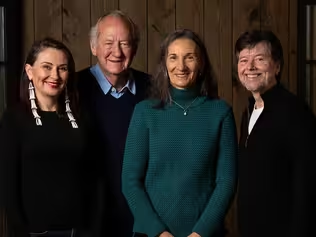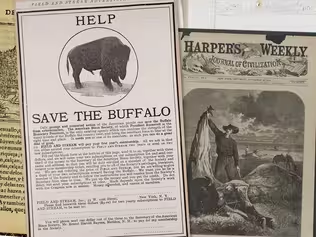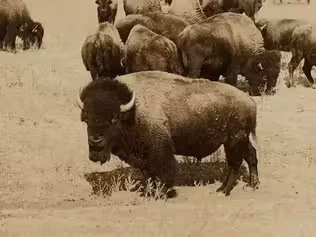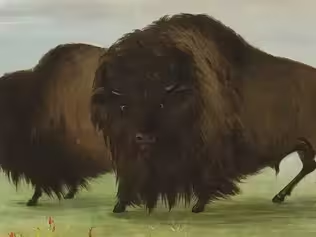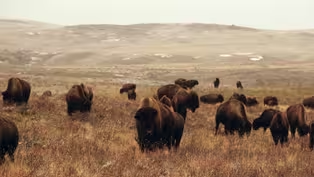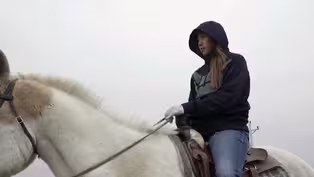
The Wolakota Buffalo Project
Clip: Special | 5m 51sVideo has Closed Captions
The Rosebud Indian Reservations Wolakota Project aims to bring the buffalo home.
The Rosebud Indian Reservation is moving forward on their Wolakota Project to bring the buffalo home to restore the Buffalo Nation. Wolakota means "The Lakota way of life." 40 square miles of ranchland owned by the reservation is being converted to a buffalo range. SDPB visits the leaders working on this monumental effort.
Problems playing video? | Closed Captioning Feedback
Problems playing video? | Closed Captioning Feedback
Corporate funding for The American Buffalo was provided by Bank of America. Major funding was provided by the Corporation for Public Broadcasting, and by The Better Angels Society and its...

The Wolakota Buffalo Project
Clip: Special | 5m 51sVideo has Closed Captions
The Rosebud Indian Reservation is moving forward on their Wolakota Project to bring the buffalo home to restore the Buffalo Nation. Wolakota means "The Lakota way of life." 40 square miles of ranchland owned by the reservation is being converted to a buffalo range. SDPB visits the leaders working on this monumental effort.
Problems playing video? | Closed Captioning Feedback
How to Watch The American Buffalo
The American Buffalo is available to stream on pbs.org and the free PBS App, available on iPhone, Apple TV, Android TV, Android smartphones, Amazon Fire TV, Amazon Fire Tablet, Roku, Samsung Smart TV, and Vizio.
Buy Now
Providing Support for PBS.org
Learn Moreabout PBS online sponsorship♪ ♪ LITTLE ELK: Our project is called Wolakota.
And what that means in our language is to live the Lakota way of life.
And so this idea that our identity is linked from the health and welfare and well-being of Buffalo and when they're strong, we're going to be strong again as well.
This is an opportunity to not dwell on the past, but to acknowledge it and move forward with new vision and with new light into a future that is healthy for our people, for our region, and for the planet.
The Rosebud Sioux tribe purchased this land and then put it into trust and brought it back into their territory under their control.
Our project will create a 28,000-acre regenerative buffalo range that will be home to 1,500 buffalo.
Previously, you know, in past years it's been a working and operational cattle ranch.
We are now in the process of converting it to what will be the largest Native American-owned and managed buffalo range in the world.
Our buffalo are going to be coming from a variety of sources and in particular, we're really excited about our partnership with the U.S. Department of Interior, which has what they call a ten-year national Bison management plan, which is the plan and framework for how they manage all of their buffalo across all of their federal lands.
National Park Service and Fish and Wildlife animals.
MOYNAHAN: This Bison Working group drafted for the Secretary of the Interior, the Bison Conservation Initiative that was released in May of this year.
Part of that initiative goes to focus on doing something that has been difficult for us to do in the past, and that is to move beyond thinking about species-level management and genetic conservation and to really actively try to link ecological restoration with cultural restoration.
And so this project today is really emblematic of that effort to link ecology and culture both within the National Park System but beyond federal lands as well.
FROST: Well, we're all about preservation and culture, cultural heritage and natural resource heritage.
And so bison sort of fits all those categories.
I mean, they're extraordinary national resource, they're the national mammal, but they're also very important culturally to Native Americans.
And so this project is just perfect for the mission of what the National Park Service is.
And in addition, enhancing bison conservation across the country and at a landscape scale.
LITTLE ELK: This is the first time that a nonfederal entity is a part of that National Bison Management Plan, which means that we'll be able to receive and also exchange buffalo with all the fish and wildlife herds, with all of the national park herds.
The beginning and the start of this herd is coming from the Badlands National Park in South Dakota and the Theodore Roosevelt Park in North Dakota.
PFLAUM: Our involvement in this project at Badlands National Park was essentially to provide 50 bison for the establishment of this new herd at Rosebud and, you know, the great credit is due to our research, outstanding resources team and field employees at Badlands National Park who not only help, day to day, with managing the second-largest herd of bison in the National Park System, but also on an annual or every two-year basis, capturing bison for distribution of surplus bison.
ROSS: Theodore Roosevelt National Park also rounded up 50 bison for this donation to the Rosebud Sioux Tribe.
And we were in conversations with the Rosebud Sioux tribe, I believe it was the Red Cow group, and Wizipan was describing how the tribe would like to have a bison herd that represented culturally the tribal makeup of people.
So having grandfathers, grandmothers, mothers, fathers, younger people, um children in that bison herd was very important from a cultural perspective.
MOYNAHAN: This project goes beyond just delivering bison to tribes.
This project is really oriented to achieve multiple goals.
So ecological restoration and cultural restoration for sure.
It also intends to hit marks for economic development, some job creation here on the reservation and food sovereignty for the Rosebud nations.
LITTLE ELK: This is an opportunity for us to do what we call the development and implementation of local solutions to global challenges.
And this is going to be an example not only for other native nations, but really for the rest of the world to look at and say, hey, these guys are doing something pretty cool out in the middle of what we now call South Dakota.
We can do that in our area, in our territory as well.
Video has Closed Captions
Clip: Special | 18m 44s | An intimate look at the only indigenous tribal-led buffalo drive in North America. (18m 44s)
Video has Closed Captions
Clip: Special | 9m 30s | Iniskim follows a young woman’s journey to recovery by reconnecting with the buffalo. (9m 30s)
Providing Support for PBS.org
Learn Moreabout PBS online sponsorshipSupport for PBS provided by:
Corporate funding for The American Buffalo was provided by Bank of America. Major funding was provided by the Corporation for Public Broadcasting, and by The Better Angels Society and its...

